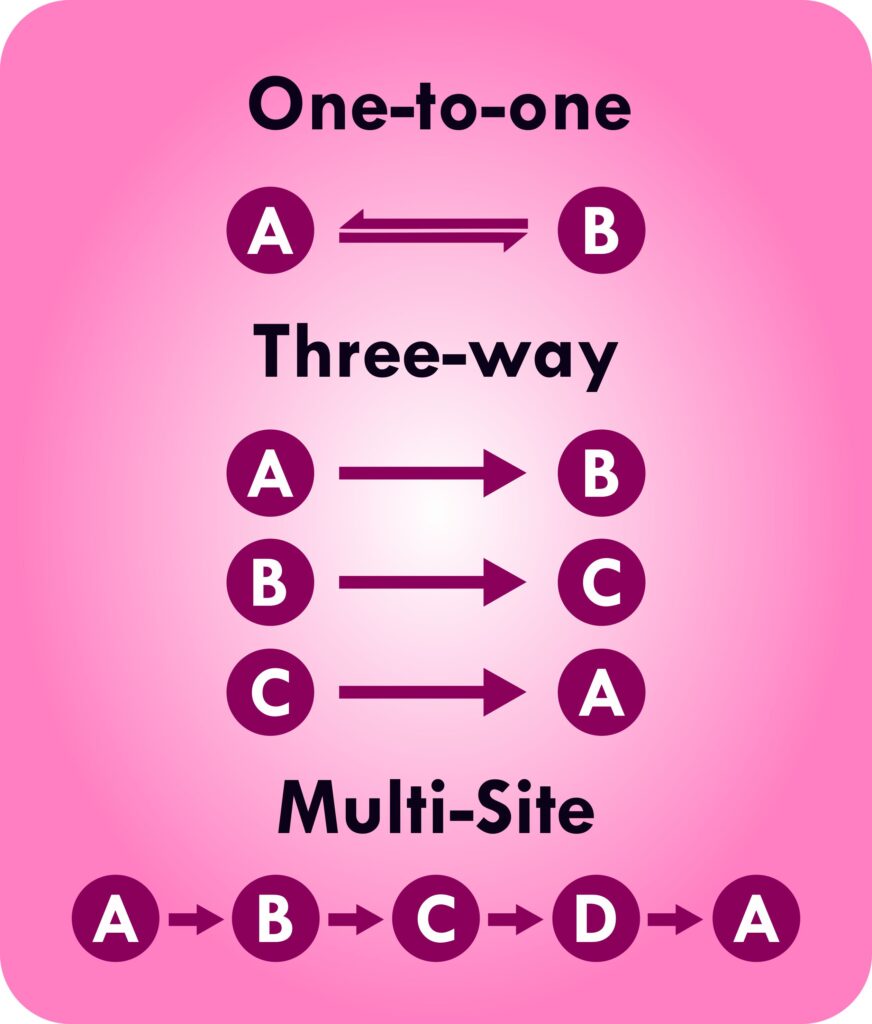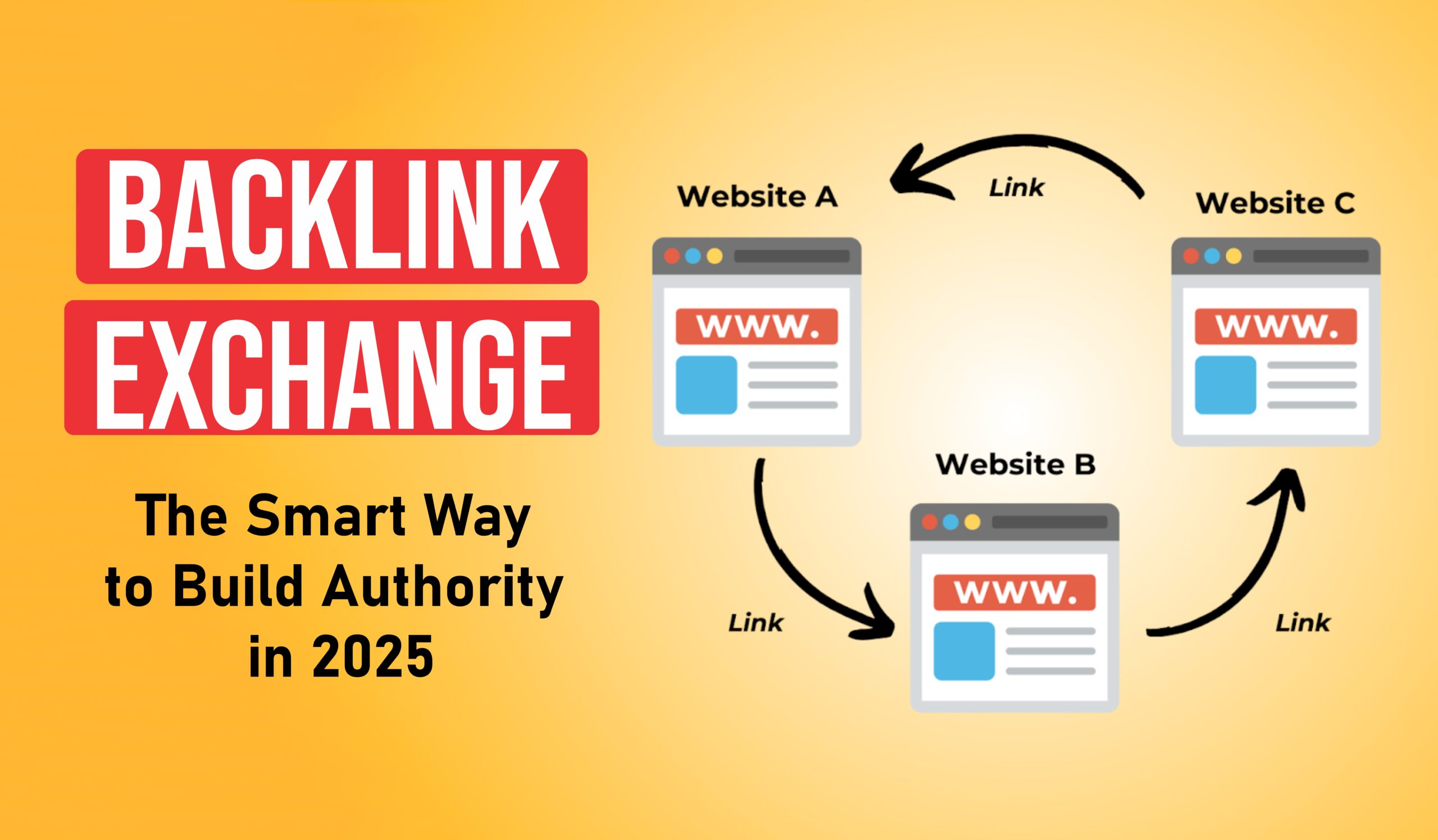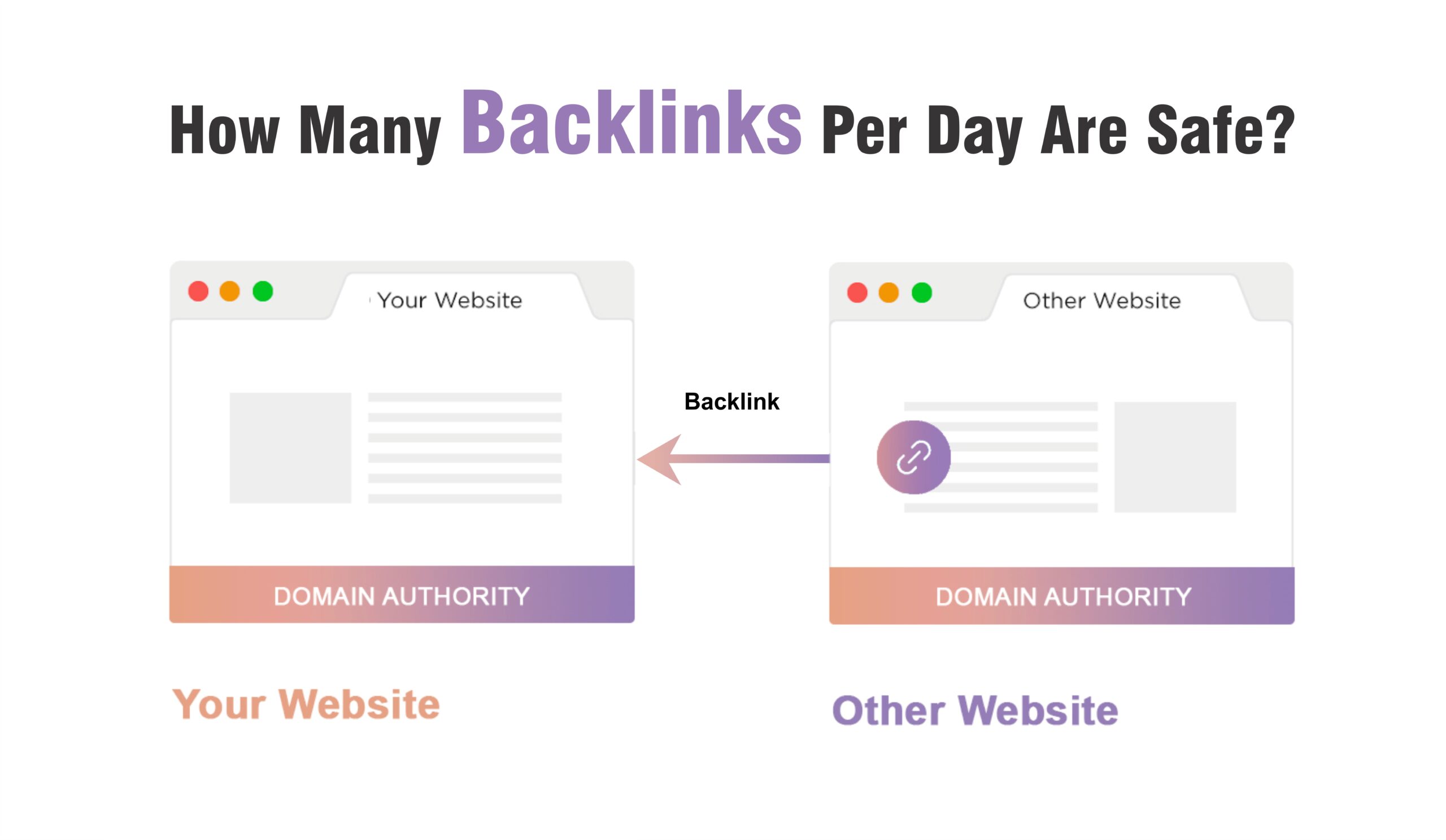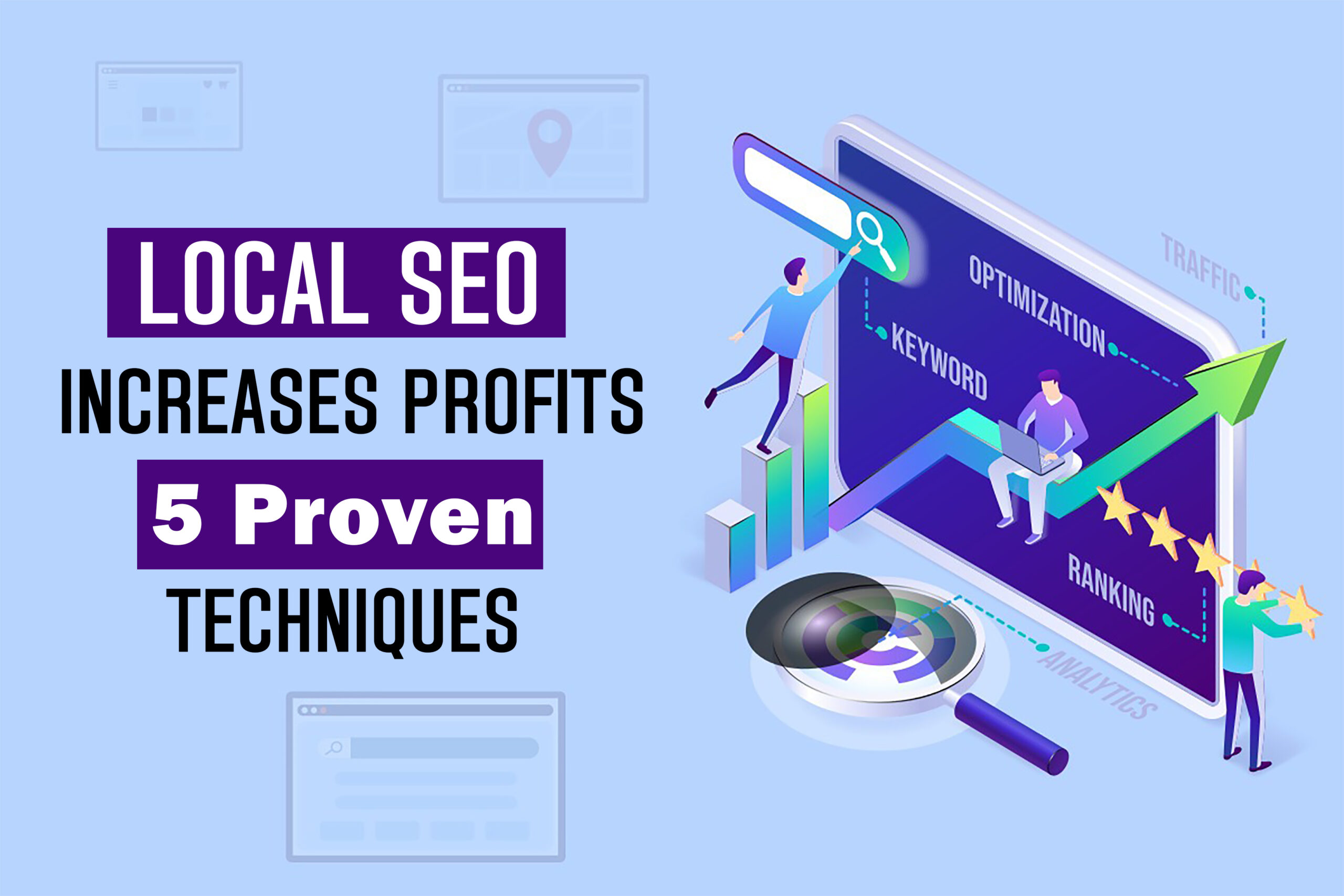Let’s break down what backlink exchanges are, how to do them safely, and how to avoid penalties while scaling your rankings with reciprocal backlinks and contextual links.
What Is a Backlink Exchange?
Definition of Backlink Exchange in SEO
A backlink exchange means two websites give each other a backlink to help boost authority. It’s often called link swapping or reciprocal linking. The goal? Enhance your SEO metrics by acquiring links from other reputable sites without incurring expenses.
If two relevant, high-quality sites exchange links that naturally fit within the content, it’s generally seen as safe. Problems arise when exchanges are spammy, unnatural, or excessive—this is where Google link schemes come in.
How Reciprocal Backlinking Works
A basic example:
- Website A adds a contextual link to Website B.
- Website B returns the favor by linking back to Website A.
This mutual backlinking builds trust when done between niche-relevant, high-authority sites. But overdoing it, especially with low-quality or irrelevant partners, can hurt your link profile and lead to penalties.
Is It Still Relevant in Modern SEO?
Yes, but the rules have changed. Backlinks exchange still works well in 2025, but only when links are placed on related, high-quality pages that offer value. Exchanging links with relevant sites, using natural anchor text, and ensuring the content helps the reader keep you in the clear.
But remember—link farm-style exchanges or participating in mass PBN schemes will put your site at risk.
Types of Link Exchanges You Should Know

One-to-One (Reciprocal Link Exchange)
This is the simplest form. Site A links to Site B, and Site B links to Site A. It works well when the exchange is organic, contextually placed, and not repeated too often with the same site.
Before swapping links, check the other site’s quality using SEO tools like Ahrefs, SEMrush. Ensure it’s trustworthy, active, and relevant to your niche.
Three-Way or ABC Link Exchanges
To avoid direct swapping patterns, many SEO professionals use a 3-way method:
- A → B
- B → C
- C → A
This masks the connection while still sharing mutual backlinks. It’s safer and more difficult for algorithms to detect, especially when paired with unique anchor text and contextual placement.
Multi-Site Circular Exchange
This involves 4+ sites linking in a circle:
- A → B → C → D → A
These are harder to track but carry risk if sites are low-authority or content isn’t semantically aligned. Always prioritize content relevance, make sure to vary anchor text, and avoid exact-match anchor spam. An unnatural footprint can alert Google’s algorithm and result in manual reviews.
Backlink Exchange via Private Blog Networks (PBNs)
Some SEOs build hidden blog networks to trade backlinks without public connections. These networks may offer fast link growth, but the risk is high. Google’s spam policies are extremely clear about link farms, link manipulation, and automated link schemes: get caught, and your site could be deindexed.
Stick to white-hat link-building methods, even if slower. Quality always beats quantity. PBNs are risky, especially after updates to Google’s algorithm that target unnatural link behavior.
Why People Use Backlink Exchanges in 2025
Boosting Domain Authority (DA) & PageRank
Securing relevant backlinks through exchanges can elevate a site’s Domain Authority (DA) and Domain Rating (DR). Both metrics, while not official Google ranking factors, are widely used by SEO tools to measure trust and authority. A stronger domain often leads to improved visibility in search engine rankings, making this a priority for many site owners.
Backlinks are still one of the top signals Google uses to determine the credibility of a website. If done right, exchanging backlinks with trusted sites can make your website look more credible to Google in 2025.
Improving Organic Rankings Quickly
One reason SEOs and businesses turn to backlink exchanges is the potential for quick movement in rankings. Unlike content marketing or digital PR, which can take months to produce results, strategic reciprocal linking with authority sites in your niche may give you a short-term rankings boost, especially for low-competition keywords.
However, the emphasis must remain on niche relevance, anchor text variation, and safe linking practices to ensure long-term gains.
Driving Referral Traffic Without Paid Ads
Besides SEO impact, backlink exchange can be a strong source of referral traffic. If you link with relevant blogs, tools, or partner sites that share your audience, you can benefit from consistent, high-quality traffic. Unlike paid ads, which stop delivering once your budget ends, a good contextual link can continue driving visitors for months or years.
People trust recommendations from credible sources. A well-placed link can act like a mini-endorsement, improving traffic flow and even conversions.
Benefits of Safe Backlink Exchange Strategies
Cost-Effective Compared to Guest Posting
Guest blogging is powerful but often time-consuming. These days, some websites ask for money to place or edit links, turning link-building into a paid strategy. In contrast, a well-negotiated backlink exchange—especially with websites you already collaborate with—can save both time and money.
Contextual link exchanges between established blogs or SaaS websites can replace the need for constant outreach campaigns. This makes them a scalable part of modern link-building strategies.
Strengthening Niche Authority
Swapping backlinks within your topic not only boosts SEO but also builds perceived authority in your industry. Google’s algorithms, particularly after helpful content updates, give preference to topical relevance. By linking to and getting links from other respected voices in your space, you establish your authority.
Think of it as joining a digital conversation—relevant link mentions reinforce your credibility in front of search engines and readers alike.
Easier Than Outreach or Cold Pitching
If you’ve done traditional link building, you know how tiring it is to send 50–100 outreach emails just to get a single backlink. With a proper backlink exchange sheet or community group, you can skip this hassle.
Finding exchange partners via Facebook Groups, Slack Channels, or SEO forums makes the process smoother. You collaborate with people who already understand the value of link exchanges, reducing friction and increasing your chances of success.
The Dark Side: Risks & Penalties of Bad Exchanges
Google Penalties for Link Schemes
Google’s Webmaster Guidelines clearly define link schemes as manipulative. Overuse of backlink exchanges, especially if they are excessive or irrelevant, may trigger manual actions or algorithmic penalties.
For example, if your site is part of dozens of exchanges with unrelated or low-quality blogs, it may get flagged. This can lead to deindexed pages or a steep drop in organic traffic. Use Broken Link Checker tools to ensure you’re not inheriting links from penalized or expired domains.
Spammy Links That Can Ruin Your SEO
Not all backlinks are created equal. If you get links from shady or unrelated websites, it can hurt your SEO instead of helping. Tools like Moz’s Spam Score and Ahrefs’ toxic link checker help assess the risk.
A single bad exchange could invite an entire set of negative SEO consequences, especially if the anchor texts are unnatural or over-optimized.
Algorithm Updates That Could Devalue Swapped Links
Google regularly updates its algorithm to combat link manipulation. These updates often target unnatural link-building footprints. Even if you follow a 3-way exchange method, the algorithm may detect link patterns and devalue them.
Therefore, focus on editorial backlinks, anchor text variation, and link profile diversity. Relying too heavily on any single strategy—including link exchanges—can make your site vulnerable.
Google’s Official Guidelines on Link Exchanges
What Google Considers a Link Scheme
Google is crystal clear in its stance on manipulative link practices. According to their documentation, “Excessive link exchanges, or partner pages created exclusively for cross-linking, violate our quality guidelines.” That means if your site is participating in schemes where the primary intention is to manipulate PageRank or rankings through links, you’re stepping into risky territory.
Any kind of automated link exchange or platforms built solely to swap links without context or editorial value are considered violations. Even three-way link exchanges can be flagged if they lack niche relevance or contain over-optimized anchor text.
How to Stay White-Hat in a Grey-Hat Game
To stay compliant and safe, every backlink exchange must serve real user intent. Don’t just trade links for SEO gains—exchange based on value, offer, relevance, and content fit.
You should:
- Link only where it makes sense contextually.
- Avoid duplicate or generic anchor text.
- Ensure both sites benefit from referral traffic and user engagement.
Using tools like Google Search Console, SEMrush, and Ahrefs, you can also regularly monitor for spammy patterns or sudden changes in your link profile.
How to Do a Backlink Exchange the RIGHT Way
Choosing High-Quality, Niche-Relevant Sites
Don’t exchange backlinks with just anyone. Your partner site should:
- Be in the same or a closely related industry.
- Maintain a strong Domain Authority or Domain Rating (DA/DR).
- Drive actual organic traffic (check with SimilarWeb or Ahrefs).
- Avoid having a high spam score or being part of a Private Blog Network.
Use Broken Link Checker to avoid dead-end pages and Google Spreadsheets to track your link partners systematically.
Using Natural Anchor Text Variations
Anchor text matters—a lot. Over-optimized keywords are a red flag to Google. Instead:
- Use branded, generic, or semantic anchor text.
- Make sure the page that links to you talks about the same topic or niche as yours.
- Rotate phrases like “check out this resource,” “explained here,” or “learn more about link-building strategies.”
Using different types of anchor text makes your backlink profile look natural and builds trust with search engines.
Tracking and Auditing Your Exchanged Links
Backlink exchanges don’t stop at publishing. Use tools to:
- Confirm the link is indexed and live.
- Ensure uptime (use tools like Uptime Robot).
- Track referral traffic using Google Analytics.
- Monitor link removals and replacements.
Keep a link log using Google Sheets or tools like Linkody, and perform quarterly audits to maintain link hygiene.
Backlink Exchange vs. Other Link-Building Tactics
Guest Posting vs. Link Swapping
Guest posting remains a top-tier method for white-hat link building, offering editorial backlinks that carry strong authority. However, it takes longer and often involves outreach or payment.
Link exchanges, on the other hand, are faster and can scale if done wisely. But if overused or executed without link quality checks, they can become liabilities.
HARO, Niche Edits, and Broken Link Building
- HARO (Help A Reporter Out): Offers high-authority links, but has high competition.
- Niche Edits: Insert links in aged, indexed posts. They feel natural but must be vetted.
- Broken Link Building: A win-win strategy that helps you replace dead links with your working content. It’s a great alternative to pure link exchanges.
Combine all these tactics with exchanges for link profile diversification.
Skyscraper Content with Organic Link Attraction
Build standout content that earns links on merit. The Skyscraper Technique works by:
- Finding top-performing content in your niche.
- Creating something more comprehensive and up-to-date.
- Reaching out to sites that linked to the original content.
This is pure white-hat SEO, but time-consuming.
Where to Find Reliable Link Exchange Partners
Facebook, Slack, and LinkedIn SEO Communities
You don’t need secret forums or shady deals. Most modern SEO professionals find link exchange partners in open communities. Groups on Facebook like SEO Signals Lab, B2B Bloggers Exchange, and Link Building HQ are active with members looking for ethical, niche-relevant link opportunities.
Slack channels such as Traffic Think Tank, Superpath, and Online Geniuses also have dedicated channels or threads for link exchange. These communities often moderate exchanges to ensure no spammy behavior, helping you avoid link penalties or Google’s spam filters.
On LinkedIn, simply searching for “SEO Link Building” groups or connecting with professionals who share SEO-related content can lead to trusted link partnerships.
SEO Forums & Link Exchange Platforms
While they’re not all safe, some forums and tools are still used by SEOs:
- BlackHatWorld (use extreme caution and vet partners thoroughly)
- LinkChest – a curated database of real businesses open to reciprocal backlinks
- Reddit’s r/SEO often posts open collaborations and link swap discussions
Use these platforms only if you can filter for safe link exchanges, high domain rating, and topic relevance.
Cold Outreach Tips with Hunter.io & Pitchbox
Cold outreach isn’t dead—it’s just more refined. Use Hunter.io to find verified contact emails from niche-relevant websites, and Pitchbox to send and manage campaigns at scale.
Keep your message short, genuine, and value-focused:
- Mention a specific article of theirs you liked.
- Suggest how a backlink to your article would benefit their audience.
- Offer a link back from your site in a relevant post.
This one-to-one approach is slower but highly targeted. Track responses using Google Sheets or CRM tools.
Link Exchange Tools That Make Life Easier
SEMrush & Ahrefs for Backlink Analysis
These are must-have tools for every serious SEO. With Ahrefs or SEMrush, you can:
- Analyze the link profile of your partner sites
- Check DR (Domain Rating), referring domains, and anchor text distribution
- Spot spammy patterns or paid links to avoid red flags
This helps you filter out poor-quality sites and only work with clean, authoritative domains.
Moz Link Explorer for Domain Authority Checks
Moz is still widely trusted for checking DA, spam score, and link freshness. Its interface is beginner-friendly and gives you an instant snapshot of:
- The number of total backlinks
- Top linking domains
- Inbound-outbound link ratios
- Toxic or flagged links
Use it as a double-check tool before any exchange agreement.
Monitor Backlinks & Linkody for Link Tracking
After a successful swap, you want to track if:
- The link is still live
- The link is indexed by Google
- The page is driving referral traffic
Monitor Backlinks, Linkody, and even SEO PowerSuite offer visual dashboards for monitoring your exchanges. Use alerts to be notified if someone removes your link after getting theirs.
Real-World Link Exchange Examples That Worked
SaaS Companies Using Strategic Exchanges
Many SaaS startups, especially in B2B, use contextual link exchange inside product comparison guides, how-to tutorials, and listicles. For example, CRM software A might link to email marketing software B in a “top growth tools” blog, and receive a backlink in return within a setup guide on the other’s site.
The key is mutual value and content alignment. No forced anchor text. No shady directories.
Bloggers Collaborating for Mutual Growth
Bloggers, especially in food, parenting, fashion, and travel niches, often link to each other’s related articles:
- “Top 10 Vegan Recipes” linking to another’s “Vegan Snacks Guide”
- Guest round-ups that feature several bloggers and their content
This drives organic traffic, improves niche authority, and builds lasting relationships.
Local SEO Link Exchange in Geo-Specific Niches
Local businesses like dentists, chiropractors, and gyms often partner in regional directories, community blogs, or even service pages:
- Dentist A links to Gym B under “local wellness partners.”
- Gym B returns the link in a blog about holistic health
This tactic boosts local relevance and visibility in map pack rankings.
Avoid These Common Backlink Exchange Mistakes
Exchanging with Irrelevant or Low-Quality Sites
Don’t accept every offer. Vet each website thoroughly:
- Check content relevance
- Confirm real traffic using SimilarWeb
- Avoid sites with high Spam Score or toxic backlink profiles
A bad link could bring more harm than help. Remember, link quality > quantity.
Over-Optimizing Anchor Text
Using the same keyword repeatedly, like “best SEO agency,” raises red flags. Mix it up:
- Branded anchors (e.g., “Risen Apex”)
- Generic anchors (“visit here”)
- Contextual phrases (“check this SEO audit guide”)
This keeps your anchor text profile diverse and natural.
Using Link Farms or Automated link exchange
Automated link exchange from link farms, PBNs, or Fiverr gigs are risky. Google’s algorithms are smart enough to detect these patterns. Stay away from tools or sellers offering 100+ backlinks in 24 hours.
White-Hat Link Exchange Tactics That Google Likes
Co-Created Blog Posts & Interviews
Create valuable content with your partner:
- Joint webinars
- Interviews featuring each other
- Collaborative case studies
These generate natural backlinks in both directions and offer editorial context.
Infographic & Visual Asset Sharing
Create high-quality infographics or checklists:
- Share them with relevant bloggers
- Offer embed code with a do-follow link back
This works great for resource pages, how-to guides, and roundup content.
Collaborative Content Campaigns
Run a co-branded content campaign like:
- Industry reports
- Niche-specific surveys
- Tools or templates (SEO calculators, keyword planners)
These often earn natural backlinks, media mentions, and shares across social media.
Monitoring the Impact of Link Exchanges
Track Referral Traffic & SEO KPIs
Use Google Analytics to monitor:
- Which exchanged links bring visitors
- Time on site and bounce rate from referred traffic
Use Search Console for:
- Click-throughs from backlink pages
- Impressions and CTR changes from new link partners
Audit Exchanged Links with Ahrefs/Moz
At least once a month:
- Check if links are still live and do-follow
- Verify anchor text is unchanged
- Use Ahrefs’ Link Intersect tool to spot shared domains
Auditing avoids blind spots and keeps your backlink profile healthy.
Check Link Indexing and Uptime Regularly
If a page isn’t indexed, the link won’t count. Use:
- site:domain.com/page-url search in Google
- Tools like Screaming Frog for bulk checks
- Uptime Robot to monitor pages where your links are placed
The Future of Link Exchanges in SEO
AI-Driven Matchmaking for Links
Emerging platforms may soon use AI algorithms to:
- Match sites with similar audiences and topics
- Filter based on DR, traffic, and link safety
- Suggest mutually beneficial exchange partners
This will streamline safe, relevant, and scalable link building.
Trust-Based Link Communities
We’ll see the rise of:
- Invite-only networks vetted by real SEOs
- Partner lists curated for editorial standards
- Focus on long-term relationships over one-off exchanges
The SEO community is already heading toward these trusted micro-networks.
Google’s Evolving Algorithm & Link Value
Links will remain critical, but contextual relevance, link placement, and user engagement will matter more than raw numbers.
A backlink from a relevant blog post with genuine traffic will always beat 10 low-quality sidebar links from random domains.
Should You Do Backlink Exchanges?
Smart Strategy or Risky Shortcut?
Backlink exchange isn’t a black-or-white topic. It depends on your execution. Done ethically, with niche-relevant partners, varied anchor text, and natural placement, it’s a powerful tactic.
But spammy, excessive, or forced link exchange is sure to backfire.
When and How to Use This Tactic Efficiently
Use backlink exchanges as:
- A secondary link-building tactic
- A way to collaborate with trusted SEO peers
- A cost-effective alternative to paid guest posts
Pair with tactics like guest blogging, HARO, content upgrades, and organic content marketing for a diversified, future-proof SEO strategy.
Frequently Asked Questions (FAQ)
1. What is a 3-way backlink exchange?
It’s when three websites link in a circle—A to B, B to C, C to A—so the swap isn’t direct.
2. Are link exchanges legal according to Google?
They’re not illegal, but excessive or spammy ones violate Google’s Webmaster Guidelines.
3. How do I know if a backlink is helping or hurting?
Check if it’s from a relevant, quality site with decent traffic and DR. Tools like Ahrefs can help.
4. Can I use backlink exchange with local SEO?
Yes. Swapping links with relevant local businesses can boost your local search visibility.
5. Is backlink exchange better than guest posting?
Not better—just different. Guest posts offer more authority, but link exchange are faster and easier.




